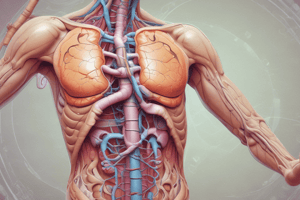Podcast
Questions and Answers
What is the blood supply for the midgut?
What is the blood supply for the midgut?
- Hepatic Artery
- Superior Mesenteric Artery (correct)
- Inferior Mesenteric Artery
- Celiac Trunk
Which nerve controls the midgut?
Which nerve controls the midgut?
- Sciatic nerve
- Spinal accessory nerve
- Vagus nerve (correct)
- Phrenic nerve
What is the cause of Midgut Volvulus?
What is the cause of Midgut Volvulus?
- Midgut wraps around the Superior Mesenteric Artery cutting off its own blood supply (correct)
- Midgut wraps around the Hepatic Artery cutting off its own blood supply
- Midgut wraps around the Inferior Mesenteric Artery cutting off its own blood supply
- Midgut wraps around the Celiac Trunk cutting off its own blood supply
What is the clinical presentation of Midgut Volvulus?
What is the clinical presentation of Midgut Volvulus?
What is the characteristic feature of achalasia on barium swallow?
What is the characteristic feature of achalasia on barium swallow?
Which condition is associated with a false diverticulum above the upper esophageal sphincter (UES)?
Which condition is associated with a false diverticulum above the upper esophageal sphincter (UES)?
What is the underlying cause of Chagas disease?
What is the underlying cause of Chagas disease?
Which cells are responsible for the production of HCl in the gastric glands?
Which cells are responsible for the production of HCl in the gastric glands?
What is the primary cause of malabsorption in children?
What is the primary cause of malabsorption in children?
Which area in the gastrointestinal tract is considered the watershed area due to its lowest blood supply?
Which area in the gastrointestinal tract is considered the watershed area due to its lowest blood supply?
What is the primary function of amniotic fluid in fetal development?
What is the primary function of amniotic fluid in fetal development?
Which phase of gastrointestinal physiology involves sensory information reaching the cortex, influencing salivation and taste?
Which phase of gastrointestinal physiology involves sensory information reaching the cortex, influencing salivation and taste?
What is the primary function of misoprostol?
What is the primary function of misoprostol?
What are the common causes of sliding and rolling hiatal hernias?
What are the common causes of sliding and rolling hiatal hernias?
Which condition is characterized by thick rugal folds and goblet cell hyperplasia?
Which condition is characterized by thick rugal folds and goblet cell hyperplasia?
What is the primary symptom of pyloric stenosis?
What is the primary symptom of pyloric stenosis?
What is the normal level for Pilocarpine sweat test used to diagnose cystic fibrosis (CF)?
What is the normal level for Pilocarpine sweat test used to diagnose cystic fibrosis (CF)?
Which complication is NOT associated with cystic fibrosis?
Which complication is NOT associated with cystic fibrosis?
Which sphincter is composed of voluntary skeletal muscle and is innervated by cranial nerves IX and X?
Which sphincter is composed of voluntary skeletal muscle and is innervated by cranial nerves IX and X?
What condition is characterized by impaired lower esophageal sphincter relaxation, leading to reflux and GERD?
What condition is characterized by impaired lower esophageal sphincter relaxation, leading to reflux and GERD?
Study Notes
Gastrointestinal Physiology and Clinical Correlation
- Pilocarpine sweat test used to diagnose cystic fibrosis (CF) with levels <40 mmol/L considered normal, 40-60 mmol/L as heterozygous, and >60 mmol/L as CF.
- Complications of CF include bronchiectasis, meconium ileus, Kartagener syndrome, obstructive lung disease, chronic granulomatous disease (CGD), pancreatitis, and infertility due to obstruction of vas deferens.
- Treatment for CF includes antibiotics for Pseudomonas and Staphylococcus aureus infections, with specific antibiotics for methicillin-sensitive Staphylococcus aureus (MSSA) and methicillin-resistant Staphylococcus aureus (MRSA).
- Swallowing process involves the rise of the tip and sides of the tongue, closure of the epiglottis, and relaxation of the upper esophageal sphincter (UES).
- Abnormalities of the gag reflex can lead to aspiration pneumonia, and feeding routes depend on the integrity of the gag reflex.
- The upper esophageal sphincter is composed of voluntary skeletal muscle and is innervated by cranial nerves IX and X, while the lower esophageal sphincter is not under voluntary control.
- Achalasia is characterized by impaired lower esophageal sphincter relaxation, leading to reflux and GERD, while dysphagia to solids and liquids is assessed through esophageal manometry.
- Gastroesophageal reflux disease (GERD) is caused by the abnormal relaxation of the lower esophageal sphincter and can lead to complications such as stricture, Barrett’s esophagus, and adenocarcinoma.
- Esophagitis can be caused by viruses, fungi, or drugs, and Barrett’s esophagus is characterized by columnar metaplasia of the esophageal epithelium.
- Mallory Weiss syndrome presents with a linear tear in the mucus membrane of the lower esophagus, often due to retching or vomiting.
- Boerhaave’s syndrome is a transmural perforation of the lower esophagus, and choanal atresia is characterized by a membrane that obstructs the airway during feeding.
- Esophageal atresia with distal tracheoesophageal fistula, H-type tracheoesophageal fistula, and esophageal webs are congenital esophageal abnormalities that may present with specific symptoms and require surgical intervention.
Studying That Suits You
Use AI to generate personalized quizzes and flashcards to suit your learning preferences.
Related Documents
Description
Test your knowledge of gastrointestinal physiology and clinical correlation with this quiz. Explore topics such as cystic fibrosis diagnosis, complications, and treatment, as well as disorders of swallowing and esophageal abnormalities. Perfect for medical students and healthcare professionals.




